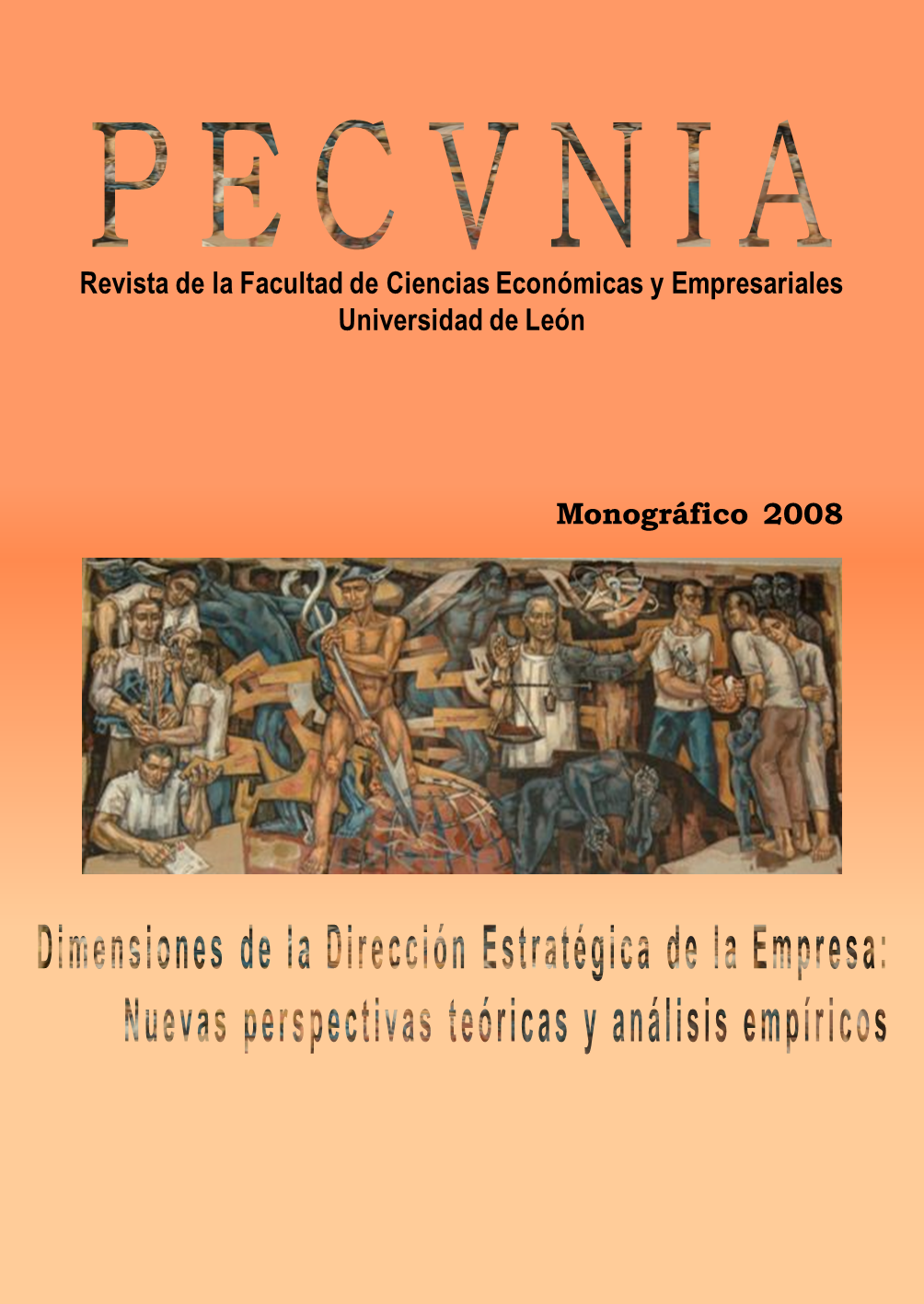Fuentes externas de conocimiento y su efecto sobre el esfuerzo innovador en los sectores industriales y de servicios en España
DOI:
https://doi.org/10.18002/pec.v0i2008.794Keywords:
Fuentes externas de innovación, Cooperación, Intensidad de la actividad innovadora (total, intramuros y extramuros, External innovation sources, Cooperation, Innovation intensity (total, intramural and extramural)Abstract
Hoy en día, no son los fabricantes los únicos encargados del desarrollo de nuevos productos, procesos o servicios, sino que se hace necesario reconocer la importancia que tienen otros agentes externos a la empresa como fuente de actividades innovadoras. La complejidad y dinamismo de los entornos actuales obliga a las empresas a complementar su base interna de conocimientos con otros procedentes del exterior. Estas circunstancias han llevado a distinguir entre fuentes internas y externas de innovación. Puesto que las primeras han sido suficientemente estudiadas y analizadas en la literatura, el presente trabajo pretende avanzar sobre el conocimiento de las segundas y sus implicaciones en la actividad innovadora de las empresas. Para ello se ha analizado la influencia de nueve de esas fuentes externas sobre la intensidad total de la actividad innovadora y de las actividades de I+D intramuros y extramuros del conjunto del sector productivo español durante el periodo 2001-2003, llegando a la conclusión de que los clientes son quienes mayor impacto ejercen en los tres casos.Manufacturers are currently not the only ones in charge of developing new products, processes or services. Instead, nowadays it is necessary to recognize the importante of other external agents to the organization as sources of innovation activities. The present complex and dynamic environments force organizations to complement their internal knowledge with other sorts of external information. These circumstances have created a distinction between internal and external innovation sources. Given that the first have been studied and analysed thoroughly in the literature, the present study tries to advance in the understanding of the second and its mplications with regard to the organizations' innovation activities. In order to achieve this objective, the present article analyzes the effect of nine external sources on the total innovation activity intensity and also on the internal and external R&D activities of the whole Spanish productive sector during the period spanning from 2001 to 2003. This study concludes that cooperation with customers had the most significant effect in all of the tree cases.
Downloads
References
BARNEY, J.B. (1986a) "Strategic Factor Markets: Expectations, Luck, and Business Strategy", Management Science, Vol. 32, 10, pp. 1231-1241.
BARNEY, J.B. (1986b) "Organizational Culture: Can It Be a Source of Sustained Competitive Advantage?", Academy of Management Review, Vol. 11, 3, pp. 656-665.
BARNEY, J.B. (1991) "Firm Resources and Sustained Competitive Advantage", Journal of Management, Vol. 17, 1, pp. 99-120.
BARNEY, J.B. (1995) "Looking Inside for Competitive Advantage", Academy of Management Executive, Vol. 9, pp. 49-61.
BARNEY, J.B. (2001) "Is the Resource-Based 'View' a Useful Perspective for Strategic Management Research? Yes", Academy of Management Review, Vol. 26, , pp. 41-56.
CHAN, T.Y. & J.F. LEE (2004) "A Comparative Study of Online User Communities Involvement In Product Innovation and Development", th International Conference on Management of Technology, IAMOT.
COHEN, W.M. & D.A. LEVINTHAL (1989) "Innovation and Learning: The Two Faces of R&D", The Economic Journal, Vol. 99, 397, pp. 569-596.
DIERICKX, I. & K. COOL (1989) "Asset Stock Accumulation and Sustainability of Competitive Advantage", Management Science, Vol. 35, 12, pp. -1511.
FRANKE, N. & S. SHAH (2003) "How Communities Support Innovative Activities: An Exploration of Assistance and Sharing Among End-Users", Research Policy, Vol. 32, 1, pp. 157-178.
HAGEDOORN, J. (1993) "Understanding the Rationale of Strategic Technology Partnering: Interorganizational Models of Cooperation and Sectorial Differences", Strategic Management Journal, Vol. 14, 5, pp. 371-385.
HENKEL, J. & E. VON HIPPEL (2004) "Welfare Implications of User Innovation", The Journal of Technology Transfer, Vol. 30, 1-2, pp. 73-87.
HERSTATT, C. & E. VON HIPPEL (1992) "FROM EXPERIENCE: Developing NewProduct Concepts Via the Lead User Method: A Case Study in a 'Low-Tech' Field", Journal of Product Innovation Management, Vol. 9, 3, pp. -221.
HLADIK, K. (1985) International Joint Ventures. Lexington, Massachusetts: Lexington Books.
INSTITUTO NACIONAL DE ESTADÍSTICA (2003) Encuesta sobre Innovación Tecnológica de las Empresas 2003. Madrid: INE.
JEPPESEN, L.B. (2002) "Making Consumer Knowledge Available and Useful. The Case of the Computer Games", DRUID Working Paper nº 01-10, 2ª version.
JEPPESEN, L.B. (2005) "User Toolkits for Innovation: Consumers Support Each Other", Journal of Product Innovation Management, Vol. 22, 4, pp. 347-362.
LILIEN, G.L. et al. (2002) "Performance Assessment of the Lead User Idea-Generation Process for New Product Development", Management Science, Vol. 48, 8, pp. 1042-1059.
LINK, A. & L. BAUER (1989) Cooperative Research in U.S. Manufacturing. Lexintong, Massachussetts: Lexington Books.
LUNDVALL, B.A. (1988) "Innovation as an Interactive Process: from User Producer Interaction to the National System of Innovation". G. DOSI et al. (eds.) Technical Change and Economic Theory. Londres, UK.: Printer Publishers, pp. 349-369.
LÜTHJE, C. (2004) "Characteristics of Innovating Users in a Consumer Goods Field: An Empirical Study of Sport-Related Product Consumers", Technovation, Vol. 24, 9, pp. 683-695.
LÜTHJE, C., C. HERSTATT & E. VON HIPPEL (2005) "User-Innovators and 'Local' Information: The Case of Mountain Biking", Research Policy, Vol. 34, 6, pp. 951-965.
MALERBA, F. (2005) "Sectoral Systems: How and Why Innovation Differs Across Sectors". J. FAGERBERG, D. MOWERY & R. NELSON (Eds.) The Oxford Handbook of Innovation. New York: Oxford University Press.
MARSHALL, A. (1925) Principles of Economics. Londres, UK.: Macmillan. OCDE (1997) OECD Proposed Guidelines for Collecting and Interpreting Technological Innovation Data - Oslo Manual. Paris: OECD Publications Service.
PENROSE, E.T. (1959) The Theory of the Growth of the Firm. New York: Wiley.
PETERAF, M.A. (1993) "The Cornerstones of Competitive Advantage: A Resource Based-View", Strategic Management Journal, Vol. 14, 3, pp. -191.
RAY, G.; J.B. BARNEY & W.A. MUHANNA (2004) "Capabilities, Business Processes, and Competitive Advantage: Choosing the Dependent Variable in Empirical Tests of the Resource-Based View", Strategic Management Journal, Vol. 25, 1, pp. 23-37.
ROSENBERG, N. (1976) Perspectives on Technology. Cambridge: Cambridge University Press.
SHAH, S. (2000) "Sources and Patterns of Innovation in a Consumer Products Field: Innovations in Sporting Equipment", MIT Sloan School of Management, Working Paper nº 4105.
TEECE, D.J. (1984) "Economic Analysis and Strategic Management", California Management Review, Vol. 26, 3, pp. 87-110.
THOMKE, S. & A. NIMGADE (1998) "Note on Lead User Research", Harvard Business School. Note: 9-699-014.
VON HIPPEL, E. (1976) "The Dominant Role of Users in the Scientific Instrument Innovation Process", Research Policy, Vol. 5, 2, pp. 212-239.
VON HIPPEL, E. (1977a) "The Dominant Role of the User in Semiconductor and Electronic Subassembly Process Innovation", IEEE Transactions on Engineering Management EM-24, pp. 60-71.
VON HIPPEL, E. (1986) "Lead Users: A Source of Novel Product Concepts", Management Science, Vol. 32, 7, pp. 791-805.
VON HIPPEL, E. (1998) "Economics of Product Development by Users: The Impact of 'sticky' Local Information", Management Science, Vol. 44, 5, pp. 629-
VON HIPPEL, E. (2005) Democratizing Innovation. Cambridge, MA.: MIT Press.
WANG, J.C. (1994) "Cooperative Research in a Newly Industrialized Country: Taiwan", Research Policy, Vol. 23, pp. 697-711.
WERNERFELT, B. (1984) "A Resource Base View of the Firm", Strategic Management Journal, Vol. 5, pp. 171-180.
Downloads
Published
How to Cite
Issue
Section
License
Copyright (c) 2008 Gloria Sánchez González, Liliana Herrera

This work is licensed under a Creative Commons Attribution-NonCommercial-ShareAlike 4.0 International License.
Los autores que publican en esta revista están de acuerdo con los siguientes términos:- Los autores ceden de forma no exclusiva los derechos de explotación (reproducción, distribución, comunicación pública, transformación) a la Universidad de León, por lo que pueden establecer, por separado, acuerdos adicionales para la distribución no exclusiva de la versión de la obra publicada en la revista (por ejemplo, alojarlo en un repositorio institucional o publicarlo en un libro), con un reconocimiento de su publicación inicial en esta revista.
- Este trabajo se encuentra bajo la Creative Commons Attribution-NonCommercial-ShareAlike 4.0 International License. Puede consultarse desde aquí la versión informativa y el texto legal de la licencia.
- Se permite y se anima a los autores a difundir electrónicamente las versiones pre-print (versión antes de ser evaluada) y/o post-print (versión evaluada y aceptada para su publicación) de sus obras antes de su publicación, ya que favorece su circulación y difusión más temprana y con ello un posible aumento en su citación y alcance entre la comunidad académica.












